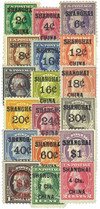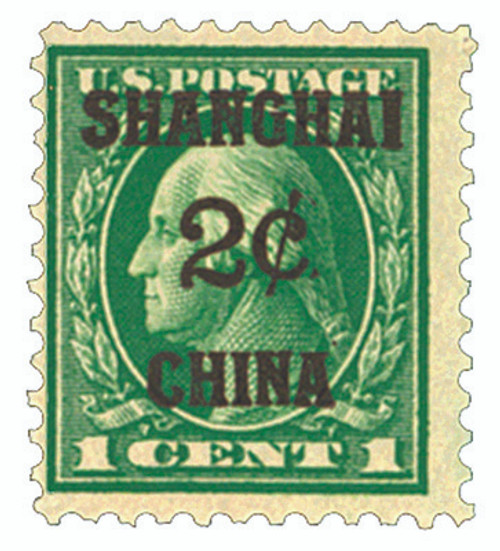
# K1-18 - 1919-22 Shanghai Overprints - Complete Set
U.S. Issues Shanghai Stamps
U.S. merchants began trading with China after the Revolutionary War, with much of the business conducted in the port city of Shanghai. After the First Opium War and the signing of the Treaty of Nanking, America established formal diplomatic relations with China. Under this agreement, Americans were allowed to buy land and build hospitals and churches. U.S. settlements in China were much like home, with U.S. laws and amenities. The U.S. maintained its own courts, police and armed forces.

Initially, American mail had to pass through the British post office in Hong Kong, but that proved expensive and unreliable. Then in 1865, the U.S. Post Office was authorized to provide its own mail service to China. The Pacific Mail Steamship Company built four ships to carry mail from San Francisco, through Japan, to Shanghai.
When mail service first began, it cost 10¢ to send a letter to China. This was later lowered to 5¢ with the establishment of the Universal Postal Union, which regulated how mail was sent between countries. Starting in June 1903, U.S. domestic postage rates were applied to Shanghai mail.
At first, the U.S. Postal Agency accepted payment in U.S. currency only, which was inconvenient for many customers. By not accepting Chinese currency, the Postal Agency was also hurting its revenue. That changed in 1919, when they finally decided to accept Chinese currency. By that time, the value of the Chinese tael was equal to half a U.S. dollar. New stamps were printed with the exchange rate, which was double the stamp’s face value. So the 1¢ stamp was overprinted 2¢, the 2¢ stamp was overprinted 4¢ and so on.

The first of these stamps, overprinted by the Bureau of Engraving and Printing, were issued on May 24, 1919. They were then placed on sale in Shanghai that July 1. Two of the stamps, K17 and K18, issued in July 1922, were overprinted in Shanghai. They were the result of a shortage created when stamps from the U.S. failed to arrive. The U.S. stamps overprinted were #498-99, #502-04, #506-10, #512, and #514-18.
U.S. stamps were also available without overprints in Shanghai. It was all a matter of how the customer was paying… if they bought a stamp with U.S. currency, they received a normal U.S. stamp, but if they purchased a stamp with Chinese currency, they received an overprint.
U.S. Issues Shanghai Stamps
U.S. merchants began trading with China after the Revolutionary War, with much of the business conducted in the port city of Shanghai. After the First Opium War and the signing of the Treaty of Nanking, America established formal diplomatic relations with China. Under this agreement, Americans were allowed to buy land and build hospitals and churches. U.S. settlements in China were much like home, with U.S. laws and amenities. The U.S. maintained its own courts, police and armed forces.

Initially, American mail had to pass through the British post office in Hong Kong, but that proved expensive and unreliable. Then in 1865, the U.S. Post Office was authorized to provide its own mail service to China. The Pacific Mail Steamship Company built four ships to carry mail from San Francisco, through Japan, to Shanghai.
When mail service first began, it cost 10¢ to send a letter to China. This was later lowered to 5¢ with the establishment of the Universal Postal Union, which regulated how mail was sent between countries. Starting in June 1903, U.S. domestic postage rates were applied to Shanghai mail.
At first, the U.S. Postal Agency accepted payment in U.S. currency only, which was inconvenient for many customers. By not accepting Chinese currency, the Postal Agency was also hurting its revenue. That changed in 1919, when they finally decided to accept Chinese currency. By that time, the value of the Chinese tael was equal to half a U.S. dollar. New stamps were printed with the exchange rate, which was double the stamp’s face value. So the 1¢ stamp was overprinted 2¢, the 2¢ stamp was overprinted 4¢ and so on.

The first of these stamps, overprinted by the Bureau of Engraving and Printing, were issued on May 24, 1919. They were then placed on sale in Shanghai that July 1. Two of the stamps, K17 and K18, issued in July 1922, were overprinted in Shanghai. They were the result of a shortage created when stamps from the U.S. failed to arrive. The U.S. stamps overprinted were #498-99, #502-04, #506-10, #512, and #514-18.
U.S. stamps were also available without overprints in Shanghai. It was all a matter of how the customer was paying… if they bought a stamp with U.S. currency, they received a normal U.S. stamp, but if they purchased a stamp with Chinese currency, they received an overprint.













